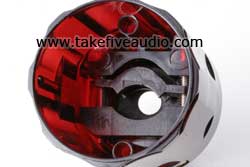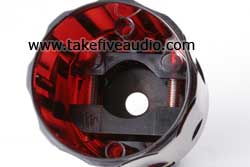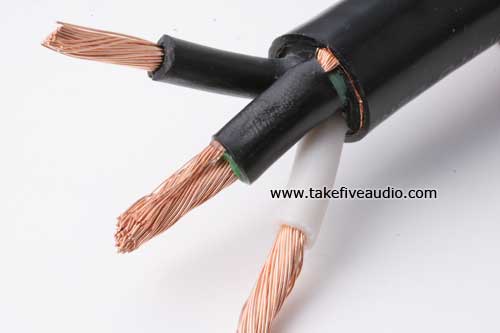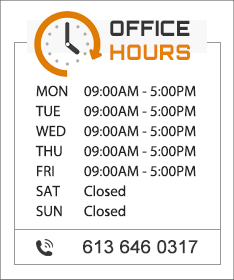Terminating The Oyaide Tunami Power Cable
Tunami Powercord
Terminating the Oyaide Tunami power cable is very straight forward and requires only a few common tools. Any connector can be used as long as it will take a 10 gauge stranded wire and an overall cable O.D. of 15 mm. We used the Oyaide P079 and C079 in this recipe. The tools needed are a utility knife, screwdriver to fit your choice of connectors, hairdryer or preferably a heatgun and a multimeter to check for shorts.
Start by gathering your parts, not many required, just your cable, connectors and a small piece of CPA 100 1/4"

The Tunami cable is directional and has an arrow printed on the jacket which indicates the proper orientation.

I usually slide on the back shells of the connectors before stripping the wires. If you are using Oyaide or Marinco connectors you will need to remove the small cord clamp insert in the backshell to accommodate the 15 mm cable. This is easily done by pushing it through with a screwdriver from the cable opening. Loosen the clamp screws till they do not protrude through the lower clamp jaw. This will allow the shell to slip easily over the cable.


Next strip 35 mm of the outer jacket at both ends. This is a little more than is recommended in the Oyaide connector instructions. The reason for this is that if the orientation of the wires is such that the Green ground wire needs to be brought to the other side of the Black/White pair 26 mm is simply too short. If the orientation of the conductors are fine then you may trim 6-8 mm off the conductors before terminating to get them to the right length. Be careful cutting into the outer jacket, the stranded Copper drain wire is just under the surface and you do not want to cut any of the strands. It may be best to remove the jacket at the IEC end first, if you should happen to cut any of the drain wire strands it does not matter since the drain wire will be cut back to the jacket and not connected on this end. The Copper foil has been removed in the picture below.

The next step is to remove the layer which surrounds the conductors. This material is soft and cuts easily with the utility knife, you must be careful not to cut into the insulation on the conductors. The photo below shows just how close the conductor insulation is to the surface.

When you have the second layer removed you may now strip 12 mm of insulation from the end of the conductors.

On the wall plug end only, the drain wire will be combined with the Ground wire (Green). We use a small piece of CPA 100 1/4" shrinktube to hold the drain wire to the ground wire, this helps to reduce the possibility of the strands from the drain wire shorting with the conductors.

At this point the connectors may be installed. Make careful note of the polarity when connecting the conductors to the plugs. Most all plugs have marks indicating polarity. The standard colour code is as follows, Black = "Live", White = "Neutral" and Green = "Ground". Your connectors will have small marks on them such as "L" and "N" indicating the polarity.
The photo below shows the wall plug connected to the cable. We mentioned earlier about cutting back the jacket 35 mm in case you had to bring the ground wire to the opposite side to make the connection, this photo shows exactly what we mean. You can see the ground wire had to be brought to the opposite side of the cable from where it naturally occured. When making the connections be extremely careful that no strands of wire from the conductors are visible, all the strands must be inside the clamp or there is a risk of a short. We treated all the conductors with Stabilant 22A before final assembly.

The IEC end is connected the same as the wall plug with the exception of the drain wire which is cut off flush with the outer jacket and not connected. Now simply slide on the back shells making sure you locate the keyway in the connector body with the keys in the shell. Screw the shell and body together and tighten the cord clamp. At this point you should use a multimeter to make one last check for shorts and correct polarity. Well. . .that's it! Connect it to your equipment and enjoy!






